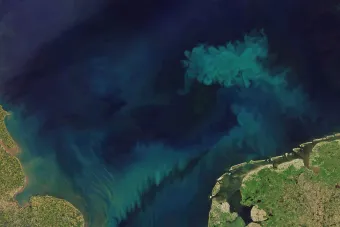
- A new study led by the National Oceanography Centre (NOC) has revealed a change in the colour of the ocean over the last 20 years.
- Scientists believe this colour difference is due to the impact of climate change on plankton ecosystems.
- This may be a concern in the future as it could lead to the ocean having less ability to store carbon.
Scientists from the National Oceanography Centre (NOC) have discovered changes in the colour of more than half (56%) of the ocean as a result of changes in the plankton communities. The new paper titled “Global climate change trends detected in indicators of ocean ecology” explains that plankton communities in around half of the world’s oceans have been affected by climate change over the past 20 years.
Plankton are tiny organisms that are carried by tides and currents and are often divided into phytoplankton which are small plants and zooplankton which are small animals.
The 20-year figure is significant as, prior to this study, the scientific consensus believed that 30 years of satellite data would be needed to detect a climate change trend in chlorophyll. However, for the first time, the paper shows that 20 years is enough time to detect a climate change related change in ocean colour. Using NASA’s Moderate Resolution Imaging Spectroradiometer (MODIS) onboard the Aqua satellite, scientists analysed measurements of ocean colour. The satellite takes measurements in seven wavelengths including the blue to green ratio that researchers often use to estimate the amount of chlorophyll.
This drastically reduces the time required to gather this important information from satellites which is the only way to measure the entire ocean simultaneously. It also means that this monitoring can be conducted in the lifespan of a single satellite as they may not last the full 30 years. It is expected to spur additional research from multiple satellite missions to create more detailed records of data with a focus on long-term satellite missions rather than the short focus missions that make up the majority of the current research.
Dr B. B. Cael, Principal Scientist from the Ocean BioGeosciences group at NOC and lead author of the paper, said. “The satellite data we studied reveal a change in the colour of a massive portion of the ocean, representing an area larger than all the land on Earth. The computer simulations we studied suggested that these colour changes may be due to climate change. The hope is that this paper will inspire additional work into the causes and effects of these changes.”
The ground-breaking study was by far the largest single detection of climate change affecting ecosystems in terms of the fraction of the earth that was covered as the entire ocean was measured. A trend of change in the plankton was detected in over half (56%) of the ocean, indicating a tremendous amount of change is underway. Whilst it is too early to determine what the change means for the ocean at large, scientists believe that climate change will drive ecosystems towards dominance by smaller kinds of plankton.
This change to smaller plankton being more dominant could be a potential cause for future concern as it could lead to the ocean having less ability to store carbon. According to the latest data from the Intergovernmental Panel on Climate Change (IPCC), plankton could account for between 5% and 17% of new carbon intake into the ocean by 2100. Smaller plankton have less ability to store this carbon, potentially limiting its effectiveness.
The paper “Global climate change trends detected in indicators of ocean ecology” is available to read online. The research was funded by NERC, NASA, Innovate UK (Horizon Europe) and Horizon 2020.